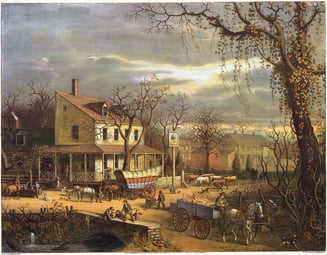The word lithograph comes from lithos, the Greek word for stone. Lithography differs from similar image-based printing methods by not requiring the artist to carve into the medium, as she would have to do with a copper engraving or a woodcut relief. Instead, she draws the image onto the smooth surface of a limestone block, and then uses oil and other substances to transfer it onto paper.
 In terms of the chemicals required, lithography is a relatively sophisticated method of illustration, and it is far younger than forms of illustration-printing like woodcuts. It was invented by a German artist and actor named Alois Senefelder in 1796. The method took off in the nineteenth century. It was especially appreciated for its accommodation of color in illustrations. Lithography has far more range than would a metal or wood engraving, which were mostly black and white. Although the lithograph was made commercially obsolete about a century ago, today, the lithograph is kept alive by enthusiasts and artisans. It is incredible to see the process in action and impossible not to admire the sometimes irreplicable illustrations the form helped create.
In terms of the chemicals required, lithography is a relatively sophisticated method of illustration, and it is far younger than forms of illustration-printing like woodcuts. It was invented by a German artist and actor named Alois Senefelder in 1796. The method took off in the nineteenth century. It was especially appreciated for its accommodation of color in illustrations. Lithography has far more range than would a metal or wood engraving, which were mostly black and white. Although the lithograph was made commercially obsolete about a century ago, today, the lithograph is kept alive by enthusiasts and artisans. It is incredible to see the process in action and impossible not to admire the sometimes irreplicable illustrations the form helped create.
This breezy and helpful video offers a crash course in chromolithography. The artist smooths the stone and draws on the surface with crayon or a special wet paint. Then that image is preserved with the treatment of nitric acid and gum arabic. This allows the ink, which otherwise would be repelled by the water on the surface, to attach to the drawing. This ink, now bonded to the illustration but repelled everywhere else, is then transferred to paper by a press. (It’s probably a good idea to pause the video at separate steps. They give you a lot of information.)
For a more complex treatment of the lithographic process, this video from the Museum of Modern Art shows how intricate the chemical cocktail can be, as well as how it may require as many as four to six prints before the image can be transferred successfully.
As if lithography didn’t have enough moving parts to get it right, this artist shows how she uses the illustrative process to achieve what constituted its great advantage 150 years ago: the ability to display multiple colors. Here, the artist creates an image using sixteen colors, using tools like a backlight that nineteenth illustrators certainly didn’t have. But with this beautiful art form, it’s a labor of love, and there’s no such thing as an easy way out. The end product shows all the effort was worth it.
This video shows how Barry Moser, a modern illustrator and Books Tell You Why favorite, has one of his drawings turned into a four-color lithograph. It takes a talented team of artisans a good while to prepare the face of the stone for ink absorption and transfer, but through a carefully executed plan, they make a striking portrait using old-fashioned techniques.









